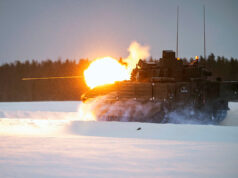In May of 2014, Defence Secretary Philip Hammond brought the proposed review of the exclusion of women from close combat roles in H.M. Forces forward from its original date in 2018. It is now expected by the close of 2014. The current exclusion is, of course, divisive, with some commentators suggesting it is an outrageous to have such a gender-discriminatory exclusion in the 21st Century whilst others argue that the inclusion of women in infantry and armour roles would inevitably lead to an unacceptable lowering of standards, and that the military is not a social laboratory. Even military women are divided on the issue. Major Judith Webb (Ret.) stated ‘We have to accept that we are different physiologically… We don’t have the same upper-body strength,’ and expressed concerns that allowing the odd exceptional woman who is capable of meeting service requirements to serve would open the way for less capable women, reducing standards. By contrast, Brigadier Nicky Moffat (Ret.) describes the arguments against lifting the exclusion as the ‘same that used to be trotted out to exclude women from the wider range of roles in which they are now allowed to serve.’
So what factors will the 2014 review take into consideration? The current terms of reference are:
- An assessment of women’s roles in recent operations.
- An internal survey to determine current attitudes within the Armed Forces towards the effectiveness of mixed gender teams in ground close combat environments.
- The engagement of external stakeholders and wider society to determine attitudes towards women in close quarter fighting.
- A review of recent research literature on the effectiveness of mixed-gender teams in a combat environment.
- Consideration of the experience of other nations in training women for and employing them in ground close combat roles.
- A review of scientific literature on gender related physiological issues relating to the performance of military tasks.
- A confirmation of the legal position and a review of relevant legal cases since 2010.
- An initial assessment of the practical issues and risks of implementing a change to the existing policy.
It is worth noting that these criteria will weigh not only practical issues but perceptual ones; the issue of whether the Armed Forces, Stakeholders and the wider public are prepared to accept females in close combat.

Some objections to women in combat roles centre around physical and psychological capability. Is there any truth to these objections? Scientifically, the answer would have to be a resounding yes. Some of these objections are patently ridiculous; hygiene is sometimes given as an example, which begs the question of how Neolithic homo-sapiens females survived without sanitary towels. Others argue that women are care-givers, not life-takers, and would be unable to kill the enemy in combat. Evidently those perpetuate these arguments are unfamiliar with the story of Lyudmila Pavlichenko, a female Soviet sniper who amassed 309 kills including 36 German snipers during WWII, or Charlotte Madison, who was an AAC pilot and weapons operator on Apache Gunships. The first pilot in AAC history to call ‘Winchester’ on a combat sortie, meaning she had expended all of her ammunition, she said of herself ‘I’ve killed more people than Harold Shipman, Myra Hindley, Jack The Ripper and any other serial killer you can name all put together.’ Evidently, women are not exclusively care-givers. However, women typically possess less muscle mass, less upper body strength, and are more apt to break bones as a consequence. A 2012 study of women in the Israeli Defence Force established that female recruits sustained a higher rate of stress fractures than males, and identified causes. It was not the first of its kind; a US Army study found that the incidence of stress fractures in female recruits was four times higher than in males.
But the most serious objection is on the level of unit cohesion. There are a variety of issues associated with it. If a male soldier sees a female soldier wounded or killed, will he cease to ‘put the mission before the man (or woman)’ and go to her aid, or fly into a rage? Will men trust that women can carry their weight as an infanteer, pull the trigger when necessary and be able to assist them if they are wounded? When the inevitable sexual tensions and relations arise, what will they do to unit cohesion? Will a mixed-gender combat unit be able to fight effectively, and keep fighting effectively when they start taking casualties?
A review of scientific literature can allay some of these fears. The higher incidence of stress fractures can be combated by building muscle mass to support the bone; studies have demonstrated that stress fractures occur less frequently in women who are already active and train with weights – which would also promote greater physical strength to be deployed to infantry tasks such as carrying crew-served weapons or wounded comrades. For that matter, higher levels of physical effort can stop a woman’s menses, putting the hygiene ‘argument’ to bed. Common sense can lay other arguments to rest. Sexual relations and tensions? We already have those in the British military. Women are embedded in combat units right now, add to which we no longer have a prohibition on homosexuality in the military. Given the low uptake of numbers in militaries in which women can serve in close combat roles, it is unlikely that removing our restriction will add any substantial degree of sexual tension or relationships to the battlefield.
One of the areas that the review will assess is the experience of foreign units. Possibly the most successful example of the integration of females into combat arms is the Canadian Armed Forces. Women are eligible for all roles, serve in armour and the infantry (the Department of National Defence is reticent on the matter of women in Special Operations Forces), and there have thus far been no issues with their capability, no lowering of standards and no negative effect on cohesion. This is not a new phenomenon – the order to integrate women into all aspects of the military barring submarines was issued in 1989, and Canada acquired its first female submariner in 2003.
How have the Canadian Forces accomplished this? Firstly, by not lowering standards; women in armour and infantry are required to pass precisely the same tests as the men, including running around fields with a fellow recruit in a fireman’s carry. Captain Ashley Colette, who was awarded the Medal of Military Valour for leading a combat platoon in Afghanistan, hauled 15-stone men around in battle exercises. Secondly, after discovering that segregating men from women in training led to poor cohesion, recruits were thrown in together, without exception. Male and female recruits eat together, sleep together and train together – and they are taught by both male and female instructors such as Sergeant Brenda Hawke, a 16-year combat veteran in the Canadian infantry, who has served in combat arms in Kosovo, Bosnia and Afghanistan. Studies have demonstrated that groups that accomplish things – such as training – together have higher cohesion, and the Canadian experience bears this out. As regards perceptual issues, the manner in which the Canadian public accepted the death of Cpt. Nicola Goddard not as the loss of a woman in combat, but the loss of a dedicated and valuable soldier was indicative of public acceptance of women in combat; remarks made by Canadian servicemen off-record to a BBC reporter to the effect that they find the UK’s attitude to women in combat patronising suggest that military acceptance has been thoroughly achieved.
An Israeli study, based on numerous sources of information available between 2002 and 2005, examined the integration of female combatants in the IDF. It reported that Commanders recognise that female combatants often exhibit superior skills in areas including discipline and motivation, maintaining alertness, shooting abilities, managing tasks in an organised manner, and displaying knowledge and professionalism in the use of weapons.
Denmark has had a similar experience – no difficulties arising as a result of integrating women in close-combat roles. Germany has had a similar experience – and since the Bundeswehr opened all roles to women, women appear to find a military career more appealing; even though few join combat arms; the number of women in the German Armed Forces has tripled since 2001 – a fact that will be of particular interest to the MOD given HM Forces’ current difficulties with recruitment and retention. Put simply, we would benefit from a new pool of manpower.
But the British are not the Canadians, or the Dutch, or the Germans. Would gender integration work as well for us? In fact, British women have already served in close combat, as attached support personnel, and have done so for years; they simply haven’t served in close combat roles. Substantial research into the British Army’s experience of cohesion in teams that included females found the men in those teams noted no loss of cohesion as a result of integrating women. They even reported improved cohesion in non-combat duties under female leadership. Some of the women reported a perceived loss of cohesion – but these women were all recent embeds, new to the unit – they hadn’t had a chance to achieve together, as the men had – and the study concluded that this was in fact responsible for the lack of perceived cohesion. One male infanteer characterised the continuing exclusion of women from combat roles as ‘proof that dinosaurs still walk the Earth.’ In fact, the study suggested that the only measurable loss of cohesion occurred when more than one female was added to a section-sized unit. At first glance, this would appear to pose a potential problem, but with the very small uptake of women in close-combat roles in other national militaries (Canada employs just 3.8%), it is entirely likely that more than one woman per section will never occur.
Objectively, it seems clear that there is no demonstrable reason why women should be excluded from combat roles other than some people don’t want them there. Our own experience of integrated units and overseas experience of integrated combat-arms units indicates no measurable impact on unit cohesion. Physical requirements can be upheld to ensure that only women who are actually capable of performing the duties of the roles in question ever actually serve in them. The men who’ve served with women in combat have no problem with working with women in combat, provided they are up to the required standard – which can be accomplished by integrating selection and training fully, thereby also ensuring cohesion. Public and military perceptions are likely to be accommodating, or at least flexible.
Taken with the news that the US – up until recently, also proponents of excluding women from combat arms – have recently opened or are planning to open the Special Warfare Combat-craft Crewman training for Riverine warfare roles, Basic Underwater Demolition/SEAL training, Ranger School and the USMC Infantry School (which has already graduated its first qualified infantrywomen) to female candidates, it would seem likely that when the review of women in combat roles is returned by years’ end, it will recommend that the exclusion should be lifted.
Except for the fact that the majority of the information above, with the exception of the last paragraph, was available when the last review on this matter took place, just four years ago. The majority of it was actually in said review. And we’re still excluding women from combat roles. So it would appear that the question is less ‘should women be allowed to serve in combat roles,’ and more ‘do dinosaurs still walk the Earth…’?













Excellent article.
[…] was written in an earlier article, analysing the roles played by women in […]
[…] was written in an earlier article, analysing the roles played by women in […]